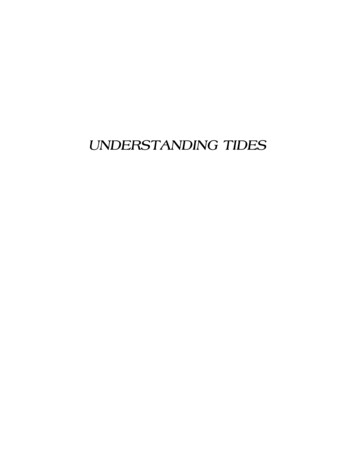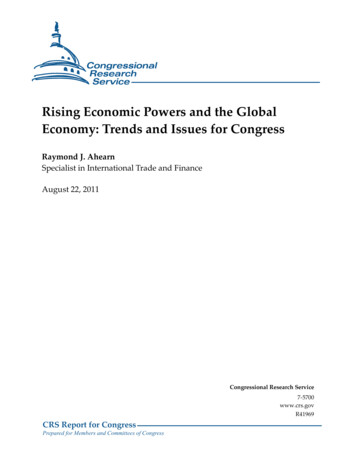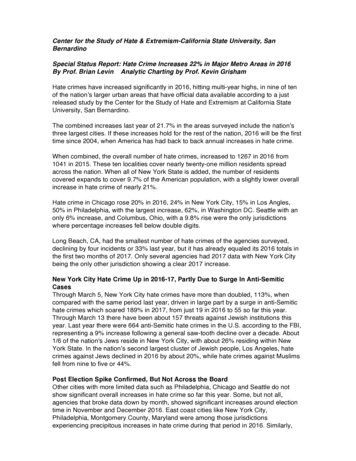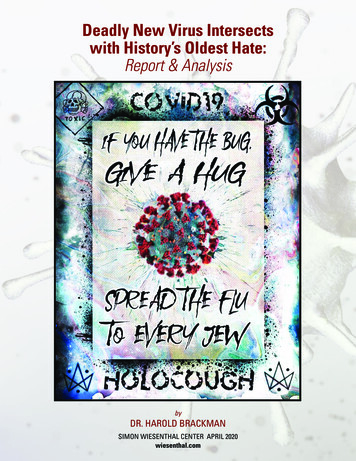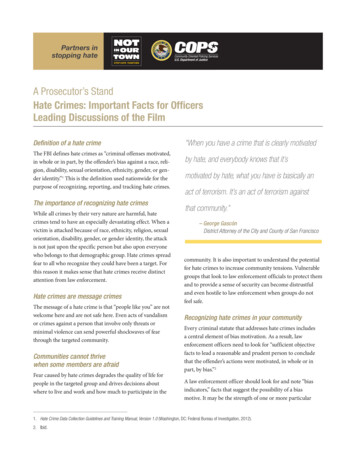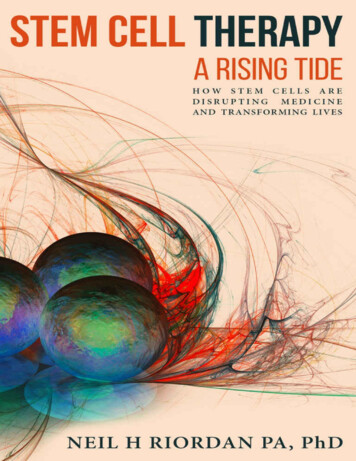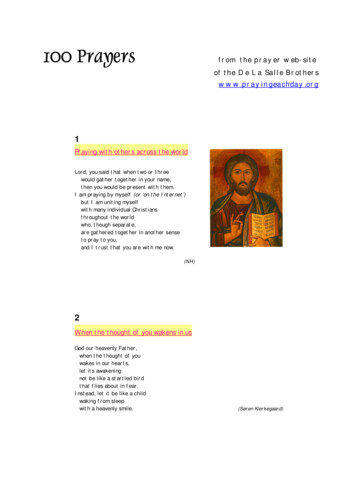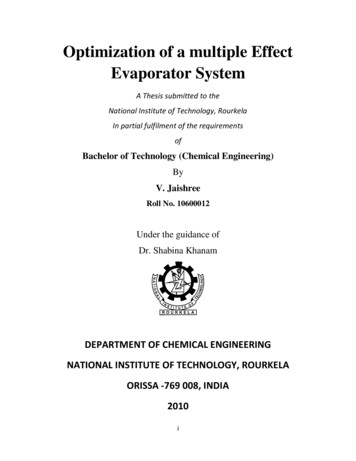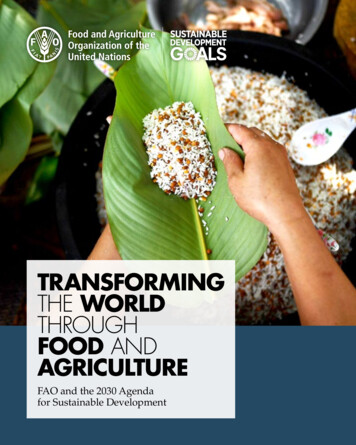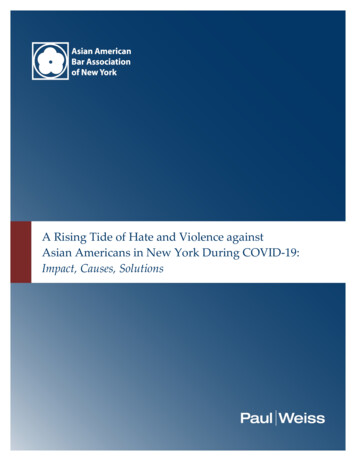
Transcription
A Rising Tide of Hate and Violence againstAsian Americans in New York During COVID-19:Impact, Causes, Solutions
COVID-19 pandemic of 2020 has directly impacted all Americans, nowheremore so than in New York City, one of the original epicenters of thepandemic in the United States. But while Americans may be united in theirsuffering because of the pandemic, the pandemic has also dividedAmerican communities.The impact of the pandemic on the Asian-American community in NewYork City is particularly profound. Beyond the pandemic’s effect on publichealth, economic growth, education, medical services, food supply, andinternational relations, the Asian-American community has been blamedfor the pandemic and the target of hate and violence.This paper discusses the data showing that anti-Asian hate and violencehave skyrocketed in 2020, focusing on the New York City region. What arethe contributing factors and causes for this disturbing rise in anti-Asianhate and violence? And what actions have politicians, law enforcement,and community organizations taken to address anti-Asian hate andviolence? How can we keep Asian Americans safe in America?
A Dedication to Corky LeeThis report is dedicated to Corky Lee, who passed away on January 27, 2021due to COVID-19.Through his life’s work of photographic justice, he ensured that AsianAmericans were part and parcel of American history. One of the last projects hedocumented was the effort to combat anti-Asian violence and harassment in thewake of COVID-19.Corky Lee personified the Asian-American movement, and AABANY honorshis memory by carrying on his work to combat indifference, injustice anddiscrimination against Asian Americans.Photo Credit: Victor Suwatcharapinun
ForewordFrank H. Wu 2021When I was a kid growing up in the Midwest in the 1970s, I knew there was something not quite rightwhen I was teased and taunted for no reason, ceaselessly if casually. My peers challenged me to kung fufights with their eyes drawn back in a slant and chanting ching-chong-chink-jap-gook. Although we werethe only family in the neighborhood who looked like us, the other Asian Americans whom I met now andthen, of every ethnic background whether male or female, had been exposed to the same. But I was toldby the adults supervising the scene to get over it, take the joke, and reply that sticks and stones wouldbreak my bones but words would never hurt me. As a consequence, I understood these incidents weremerely in my own head, of no concern to anyone else, for whom they were indeed funny.It was thanks to the murder of Vincent Chin, a Chinese American, at the hands of white autoworkers,during the depths of the recession of the early 1980s in my hometown of Detroit, the “Motor City,” that Irealized I was not alone. Although I didn’t know him, I identified with him. He was bludgeoned with abaseball bat on the eve of his wedding, while out with buddies celebrating a bachelor’s party. As cerebralmatter, spinal fluid, and blood pooled onto the pavement beneath him, spilling from a head cracked open,he uttered the last words, “It’s not fair.”His killers used the same racial epithets with which I was more familiar than I cared to be. They said,using ample obscenity, that it was because of him they were out of work, apparently referring to the influxof imported cars into the market, upsetting the American monopoly that had prevailed until then. Forgetthat he was as assimilated as could be, it was mistaken identity twice over: Chinese, not Japanese;American, not foreign. To those who took out their frustrations on him, lethally, he nonetheless embodiedToyota, Tokyo, and by extension the “Orient” which was exotic and somehow sinister. The slurs pack theirown punch. They lead to the sticks and stones.Vincent Chin was symbolic, but not of what the men who took his life believed. Pleading guilty under theterms of a deal, they never denied the act; they only argued their motivation was plain anger as if thatwere an excuse. For their transgression, they were sentenced to probation for three years and a fine of 3000 each, praised by the judge as good men who would not again do anything so bad. The older of thetwo, who according to witnesses swung the Louisville Slugger as if he were trying to hit a home run, evensued his car company employer for firing him, alleging discrimination. Chin has become iconic forexperiencing in the fatal extreme what ordinary Asian Americans endure daily. As unique as any AsianAmerican may wish to be, we face the same stereotypes and similar threats.Two generations later, for all the progress in race relations that has been made, anti-Asian violenceremains difficult to discuss, seemingly defeating even the most progressive activists. That is not only dueto the trauma inflicted on individuals and communities but also owing to the potential for Asian Americanadvocacy for civil rights to be misinterpreted. Yet anti-Asian violence is real. It is pervasive, serious, andrecurring, ranging from the common cruelty of childhood bullying to hate crimes which includeremorseless homicide. This study is much needed. For the ideals of our diverse democracy beckon the
world over as a beacon like no other. We are proud of that exceptionalism. Our ancestors or we ourselvesjourneyed through great hazards, risking and sacrificing to improve our lives and offer opportunities forour descendants. Only our own efforts, joined to universal appeals of morality, will generate change.Our nation remains riven by race, after Civil War, Reconstruction, and the struggle for Black equality thatculminated in legislation in the 1960s. Against the ongoing #BLM protests and within a context ofdisparities, white nationalism is resurgent again, overwhelming social media with grievances whichdevolve into conspiracy theories, about those others who are taking over. Those who are neither blacknor white, who perceived as newcomers even if native born (like Latinx), neither benefit from theprivileges correlated with majority status nor receive acknowledgement of problems corresponding withminority status. Asian Americans are ambiguous. We are caught “in between.”Despite our shared stake in this society we have embraced, Asian immigrants and their American-bornheirs, in some times and places including during the pandemic even in cosmopolitan New York City, feelas if we are exposed to hostility from all quarters, beset by whites, blacks, and even other AsianAmericans organized in transnational gangs. Those feelings have a basis in fact. COVID-19 in particularhas brought to the surface what bigotry might have been suspected to be lurking underneath, whetherprejudice that is suppressed for decency and etiquette or perhaps even bias which is unconscious or halfheartedly renounced. People attacking Asian Americans during the quarantine, motivated by the virus,are not fearing contagion from disease but assigning blame for it. Asian Americans are visited by revengedirected toward a specter, an advanced version of the Yellow Peril, alleged to be culpable for sins rangingfrom the Vietnam War to an invisible infection. We are guilty by association even if our grandparentslament our alienation from their traditions.There are many reasons for the omission of Asian Americans from discussions of race and civil rightswhether deliberate or negligent. We are regarded as perpetual foreigners who have no standing withinthe community to hint at an injustice over which others if it were them would be outraged. Or we areassumed to be model minorities who are all doing well. These blend together in the lingering sense thatAsians are doing better than we would back where we “really” came from, even if that is one of the manyNew York City Chinatowns, and implicitly could return to, with good riddance – overseas, as well as in theresentment which becomes racialized based on the erroneous notion that Asian Americans have gainedfrom what others have lost. Asian Americans who stand up and speak out may do so with accents, or, ifnot, told with surprise, “My, you speak English so well.”Either way, we are dismissed as irrelevant, the “Johnny come lately” whose case deserves no priority.Even people, including Asian Americans, who learned Chinese workers — 15,000 of them — built thewestern half of the transcontinental railroad completed in 1869 are not taught anything about thelynchings and mob violence that purged those same laborers from the nation after they had toiled to uniteit. The Japanese American internment of World War II may have been mentioned in school, but thegovernment finding based on what was known at the time that it was not justified by military necessitytypically is not emphasized.The evidence, ironically, confirms that Asian Americans hesitate to call out discrimination. We may bereluctant for cultural reasons to raise a fuss. Our elders warn us not to dishonor the family. Theadmonition is internalized as meaning not revealing you have been a victim, which implies your
weakness; and not attracting controversy by complaining, as if you cannot remedy the situation byyourself and without intervention. We are acutely aware of being pushed aside, as figuratively as literally,or mocked for language skills notwithstanding studious practice to imitate self-styled social superiors. Wehave encountered people whose sympathies are selective even if their rhetoric is about diversity, equity,and inclusion. People introduce their team which they praise for looking like America, and our absence isconspicuous. The more Asian Americans proclaim we belong, the more we provoke those who wouldinsist otherwise. We are expected to smile politely as if we are the guest who ought not offend their host,even if the former’s family has been here longer than the latter’s. So we cannot be sure we will receivethe modicum of consideration much less material help even from public officials who were elected torepresent all of us. To have suffered is shameful, to bring notice to it more so. The image of AsianAmericans is quiet, passive, and docile.Thus Asian Americans become easy targets. We are reputed to be tourists carrying cash who won’t fightback or even report wrongdoing. When we are targeted for assault, while out and about minding our ownbusiness, that means the aggression is not random but racial. Asian Americans also are loathe to admit,though it is true, that we can be perpetrators of misconduct toward other people of color, or bystanderswho become complicit since we show scant solicitude for their suffering. Our desire to be safe can promptus to shy away from others on the basis of assumptions, as strangers on the street at night signal whomwe trust and whom we fear. We fail ourselves if we are not our better selves.It is principled and practical for Asian Americans to pursue civic engagement and bridge building. AsianAmerican identity itself is a coalition. It brings together people whose forebears fought total wars, oneafter another, with no love lost among them. The theme of “you all look alike,” however, has inspiredinitially mutual defense on these shores and then what is genuinely “only in America.” To declare “I amAsian American” is to be an optimist.Asian Americans yearn to make good for America, in America, alongside other Americans, their coworkers and neighbors, who will accept us as we have adapted. The explanation that an Asian can be anAmerican should not be necessary, neither as a defense to atrocities, or at all. To be Asian American is tobe American, to express confidence enough in an experiment of self-governance to participatewholeheartedly. The Asian American Bar Association of New York City, the largest of local voluntary barsbased on affinity, merits praise for taking on this project. The volunteers who compiled the informationand offer recommendations are promoting the public good, through the rule of law which is the foundationof everything else we value. This document of pain is cathartic. More than that, it should be compelling.Frank H. Wu is President of Queens College, City University of New York, and author of Yellow:Race in America Beyond Black and White. The opinions expressed here are his own.
A Letter from Congresswoman Grace Meng
1. The COVID-19 Pandemic’s Impacton the Asian-American CommunityAnti-Asian hate incidents increased dramatically in thewake of the 9/11 attacks and then surged after theelection of Donald J. Trump. South Asian, Muslim, Sikh,Hindu and Middle Eastern communities all facedrecurring cycles of harassment and violence. 1 Since theonset of the pandemic, however, anti-Asian hateincidents now primarily directed at East Asians haveskyrocketed according to both official and unofficialreports. Across the country, there were more than 2,500reports of anti-Asian hate incidents related to COVID-19between March and September 2020. And this numberunderstates the actual number of anti-Asian hateincidents because most incidents are not reported.A. The Asian-American Community: Who Are We?Asians comprise 13.95% of the New York Citypopulation and 17.64% of the Asian population lives inpoverty. 2 The Asian community in New York Cityincludes native-born New Yorkers as well asimmigrants, tourists and exchange students. All havebeen severely impacted by the pandemic. The AsianAmerican community has higher-than-average businessownership, 3 and Asian-owned businesses were some ofthe earliest to experience declines at the early onset ofthe pandemic (including due to fears that COVID-19could be transmitted through Chinese food) 4. AsianAmericans have also filed a disproportionately highpercentage of unemployment claims. By mid-April,Asian Americans, who accounted for 9 percent of thestate’s labor force, had filed 14% of the state’sunemployment claims. 5 2021 Asian American Bar Association of New York, and Paul, Weiss, Rifkind, Wharton & Garrison LLP1
In the meantime, economic recovery for AsianAmericans is expected to be slow due toApproximatelyinstitutional barriers which could betwo million Asianexacerbated by racial bias. A majority (75percent) of Asian American-owned businessesAmericans arelack existing relationships with a mainstreamworking asbank or credit union and thus have littleessential workers.chance of obtaining a Paycheck ProtectionProgram (PPP) loan. 6 Asian Americans alsoface language barriers in obtaininggovernment relief: none of the four financial-relief services offered by the UnitedStates Small Business Administration provide translations into Asian languages. 7The general public may be slow to return to Asian-American businesses due tolingering bias and fear related to the pandemic.Approximately two million Asian Americans are working as essential workers. 8In the medical profession alone, Asian Americans constitute 20.4 percent ofphysicians and surgeons, 9.8 percent of registered nurses and therapists, 7.7 percentof healthcare technologists and technicians, and 6.9 percent of physician assistants,despite representing only 5.9 percent of the U.S. population. 9 In New York state,Asian Americans comprise an estimated 11.6 percent of the healthcare work force,10and within the Asian-American community, Filipinos and Fijians constitute thelargest percentage of healthcare workers at 11.5 percent and 10.1 percent,respectively. 11 The toll has been devastating for Filipino-American nurses. Nearlyone third of all nurse deaths are Filipino-American, despite making up only 4% ofall nurses in America. 12B. Anti-Asian Hate and Violence Skyrocket During the PandemicDespite Asian Americans’ long history in America and their involvement inhealthcare and small businesses in the community, hate incidents towards AsianAmericans have increased during the pandemic.There have been widespread reports of hate incidents (both physical and verbalabuse) against Asian Americans during the pandemic. Hate incidents encompass allovert acts of racial prejudice, including harassment, racial slurs, spitting, as well ashate crimes defined by statute. Overall, the collected data shows that hate incidents 2021 Asian American Bar Association of New York, and Paul, Weiss, Rifkind, Wharton & Garrison LLP2
comprise 90% of the total cases. Under federal law, a hate crime is willfully causingor attempting to cause bodily injury because of, e.g., a person’s race, color, ornational origin. 13 Other crimes, like property crimes, may also carry longer terms ofimprisonment when motivated by bias against, e.g., a person’s race, color, ornational origin. 14 In addition, nearly all states have separately enacted hate crimelaws. 15 In New York, a wide variety of criminal offenses are defined as hate crimeswhen they are motivated by bias or hate against, e.g., a person’s race, color, ornational origin, and are subject to enhanced penalties. 16For example: An Asian woman wearing a face mask was assaulted and called “diseased” in aNYC subway station in February 2020. 17 In a video clip of the incident, a manappears to be kicking and punching the woman. 18 In March 2020, a Chinese-American lawyer, her young child and husband wereverbally harassed and threatened by a woman blocks from their home. Hurlinganti-Asian invective, the event was covered in social media. Despite reportingthis to the NYPD, no arrest was ever made. 19 Also in March 2020, an Asian man was kicked from behind while walking on thestreet and fell to the ground, with the attacker adding, “F--king Chinesecoronavirus” and telling the man to go back to his country. The man also toldpolice that the attacker spat in his face. 20 Around the same time in March 2020, an Asian woman was hit by a strangerwho screamed, “Where’s your corona mask, you Asian b---h!” in Manhattan. 21 In Queens, a man and his son were yelled at by a stranger who yelled, “Where’syour f---ing mask, you Chinese b---h?” The stranger followed the man and hisson to a packed bus stop and then tried to hit the man over the head. The manwas later charged with aggravated harassment as a hate crime. 22 A writer for The New Yorker said she was taking out her trash in March 2020when a man walking by began cursing at her for being Chinese. 23 A 30-year-old from Syracuse, NY was verbally abused in a grocery store by aman who shouted, “It’s you people who brought the disease.” That same day,the victim experienced verbal abuse from two couples at Costco. 24 2021 Asian American Bar Association of New York, and Paul, Weiss, Rifkind, Wharton & Garrison LLP3
A 51-year-old Asian woman was attacked on an MTA bus by four femalesuspects who made anti-Asian statements and struck the victim on her head withan umbrella before fleeing. 25 A man harassed an Asian woman in Rego Park, Queens, with expletives. Whenthe victim tried to take a picture of the perpetrator, he slapped the phone out ofher hand. 26 In May, a 30-year-old Asian man was almost dragged out of his seat on the 4Train of the NYC subway by a stranger who called the victim an “infected Chinaboy.” 27 A man who spat on a female Asian passenger and screamed, “Asians caused thevirus!” and “Go back to China!” in a Bronx subway on July 31 was arrested onAugust 7, 2020. 28 In October, a 40-year-old Asian man was choked and punched in the face just ashe left his parked car near West 16th Street and Seventh Avenue in Manhattan.The attacker yelled racial slurs at him. 29 In December, a 32-year-old Asian woman was confronted and punched in theface by three men and three women in the subway. Police reported that she wasconfronted over not wearing a mask and anti-Asian comments were madeduring the attack. 30Asian Americans have also been the victims of countless other crimes, even thoughthey are not classified as hate crimes due to purportedly insufficient evidence ofracial animosity: A 39-year-old woman of Asian descent in Brooklyn was taking out the garbagewhen she was attacked by a stranger who poured a corrosive substance over her,leaving second degree burns to her face, neck, shoulder, and back. 31 An 89-year-old Chinese-American grandmother was assaulted in Brooklyn andthen set on fire by two perpetrators. In early September, two 13-year old boyswere arrested and charged with third-degree assault. 32 In downtown Manhattan, Judge Phyllis Chu was punched in the jaw by asuspect on a bicycle as she walked to work from the Staten Island Ferryterminal. 33 The police investigated, but made no arrests.34 2021 Asian American Bar Association of New York, and Paul, Weiss, Rifkind, Wharton & Garrison LLP4
In early October 2020, jazz pianist TadatakaUnno was attacked and beaten as he tried toexit the subway station in Harlem. No arrestshave been made. 35The data bears out the anecdotal and reportedincidents of violence against Asian Americansduring the pandemic. As of December 31, 2020,there were 259 reports of anti-Asian incidents inNew York reported to “Stop AAPI Hate,” which issponsored by the Asian Pacific Policy & PlanningCouncil, Chinese for Affirmative Action, and SanFrancisco State University’s Asian-American Studies Photo author: Ice Boy 0/deed.enDepartment. The vast majority of the incidentsinvolve verbal harassment. However, shunning,physical assault, and being coughed and spat on are also being reported in alarmingnumbers. Moreover, New York data shows a greater number of transportation-relatedincidents compared to other regions of the U.S., which is consistent with the heavy useof public transportation in New York City. The number of online hate incidentsreported underrepresents the level of anti-Asian aggression on digital platformsbecause the perpetrators’ identities are hidden and the aggression is often hate speech,as opposed to an attack on a particular individual. Current online infrastructures do nottrack or regulate hate speech. 2021 Asian American Bar Association of New York, and Paul, Weiss, Rifkind, Wharton & Garrison LLP5
Anti-Asian Discrimination in the U.S. and in New York City from March 19, 2020 to December 31, 2020(Source: Stop AAPI Hate)Similarly, between February and May 2020, the New York City Commission onHuman Rights (“NYCCHR”) received reports of 389 coronavirus-related hateincidents. 36 Of those, 145 complaints involved anti-Asian sentiment, representing37% of all complaints received. According to local newspaper City & State New York,those 145 complaints show a “tenfold increase in anti-Asian complaints filedcompared to the same period last year, which had only 12.” 37 One-third ofAmericans report that they have witnessed other individuals blame Asians for theoutbreak. 38Further, we note that incidents reported to community organizations represent asmall fraction of the actual number of incidents targeting Asian Americans. Evenfewer of those incidents are reported to the police. Nonetheless, police reports havedramatically spiked compared to the period before the pandemic. According to theNYPD, between January 1 and November 1, 2020, 24 coronavirus-related hatecrimes were reported (a category that did not exist in 2019, but which are directedagainst Asians), which is eight times the number of hate crimes reported againstAsians in the same period in 2019. 39 Indeed, in the first quarter of 2020, 23 arrestswere made for racially motivated crimes, and 39.1 percent of those were reportedwith an anti-Asian bias, compared to only 6.1 percent in 2019. 40 In the third quarter,19 hate crime arrests were made, of which 20 percent were for anti-Asian crimes. 41Meanwhile, the NYPD reports a decrease in reported hate crimes against other 2021 Asian American Bar Association of New York, and Paul, Weiss, Rifkind, Wharton & Garrison LLP6
groups during the same time period. For instance, there has been a decrease inreported hate crimes based on gender or sexual orientation, Anti-Semitic hatecrimes, and hate crimes against Muslim, Hispanic and white populations. 42(Source of data: N.Y. Police Dep’t, Hate Crimes Reports, available at is/hate-crimes.page.)Finally, we note with frustration that despite all of the incidents above, we do nothave a single prosecution of anti-Asian bias or hate crime from 2020 that we areaware of. This is also true on the civil side, where complaints to civil lawenforcement have also produced no meaningful response.2. Causes and Contributing FactorsAnti-Asian hate and violence are not new. Historically, diseases and outbreaks havebeen used to rationalize racism and xenophobia against Asian Americans andagainst other perceived “out” groups. Such racism and xenophobia is often causedby a confluence of factors, some of which has little to do with disease itself.Here too, several causes and contributing factors have given rise to anti-Asian hateand violence during the COVID-19 pandemic. In particular, actions taken by publicfigures—including elected officials within the government—and misinformation 2021 Asian American Bar Association of New York, and Paul, Weiss, Rifkind, Wharton & Garrison LLP7
and poor portrayal by the media can amplify disease-based stigma against AsianAmericans, and further normalize and fuel racism.A. History of Anti-Asian Hate and ViolenceTargeting Asian Americans as agroup to blame for the pandemicresults from underlying social,political, or economic tensions. Intimes of stress, there is a tendencyto blame groups that are seen aseconomic threats or as notassimilating or conforming. Suchirrational fear and scapegoatingare exacerbated when politicalfigures misappropriate these crisesto further their own agendas anddivert public attention from thereal causes of the underlying tensions.The irrational fear andscapegoating areexacerbated when politicalfigures misappropriatethese crises to further theirown agendas and divertpublic attention from thereal causes of theunderlying tensions.Historically, anti-Asian racism was fiercest during times of economic downturn,war, and disease. In the late 19th and early 20th centuries, there was a prevailinganti-Chinese sentiment fueled by economic fears that attributed declining wagesand unemployment to competition from Chinese laborers. When the bubonicplague hit San Francisco, Chinese immigrants were singled out and blamed. 43 Whenthe body of a Chinese laborer—suspected of having died from the plague—wasfound in Chinatown in March 1900, authorities immediately quarantinedChinatown, only to find, three and a half months later, that there were no cases ofbubonic plague within Chinatown. 44 The Chinese Exclusion Act—enacted in 1882and permanently extended in 1904 to prevent Chinese laborers from entering andobtaining citizenship in the U.S.—was also partly justified on the grounds that theChinese brought a variety of infectious diseases, including the bubonic plague, intothe country. 45The detention of Japanese Americans in internment camps during WWII, pursuantto President Roosevelt’s Executive Order 9066, was also a result of scapegoating—albeit for war—motivated by economic, social, and political tension. 46 On the West 2021 Asian American Bar Association of New York, and Paul, Weiss, Rifkind, Wharton & Garrison LLP8
Manzanar barracks. Japanese Americans were interned here during World War II.Coast, long-standing racism against Japanese Americans, motivated in part byjealousy over their commercial success, erupted into furious demands to removethem indiscriminately to relocation camps for the duration of the war. Japaneseimmigrants and their descendants, regardless of citizenship or residence status,were systematically rounded up and placed in crude, cramped detention quarters. 47In the now infamous decision of Korematsu v. United States, the Supreme Courtupheld the exclusion of Japanese Americans from the West Coast war area, denyingthe obvious racial motivations behind it. 48During the economic downturn that hit the U.S. auto industry in the 1980s, AsianAmericans were also blamed—due to the growing presence of Japanese automanufacturers in the U.S. at that time—and the scapegoating led to the death ofVincent Chin. 49 On June 19, 1982, Chin, a 27-year-old Chinese-American in Detroit,was beaten to death by two white autoworkers, Ronald Ebens and Michael Nitz. 50Ebens allegedly said to Chin, “It’s because of you little m-f-s that, we’re out ofwork.”51 Neither Ebens nor Nitz received any prison time—they were convicted ofmanslaughter, sentenced to three years’ probation and ordered to pay a 3,000fine. 52 In defense of his light sentencing, the presiding Judge Charles Kaufman said,“These aren’t the kind of men you send to jail. We’re talking here about a manwho’s held down a responsible job for 17 or 18 years, and his son is employed and 2021 Asian American Bar Association of New York, and Paul, Weiss, Rifkind, Wharton & Garrison LLP9
is a part-time student. You don’t make the punishment fit the crime, you make thepunishment fit the criminal.” 53In the aftermath of the September 11 attacks by Al-Qaeda, South Asian Americans,Muslim Americans and Middle-Eastern Americans became targets of hate andviolence based on their appearance, ethnicity, or religious affiliation. Eighty-onehate incidents against South Asians were reported nationwide in just the one weekfollowing 9/11. 54 Government and law enforcement agencies, including the NYPD,also implemented programs that subjected South and Southeast Asians tosurveillance and profiling. 55 One example is the National Security Entry-ExitRegistration System, which required men entering the U.S. from certain countries,including Bangladesh, Pakistan, and Indonesia, to be fingerprinted, interviewed,and photographed, and to check in with officials regularly. 56B. Fear and Uncertainty Stoke Anti-Asian Hate During the PandemicThe rise of anti-Asian hate and violence during the pandemic is in part explained asa reaction to uncertainty and fear. One response to the threat of disease is toconform with what are per
we trust and whom we fear. We fail ourselves if we are not our better selves. It is principled and practical for Asian Americans to pursue civic engagement and bridge building. Asian American identity itself is a coalition. It brings together people whose forebears fought total wars, one after another, with no love lost among them.
